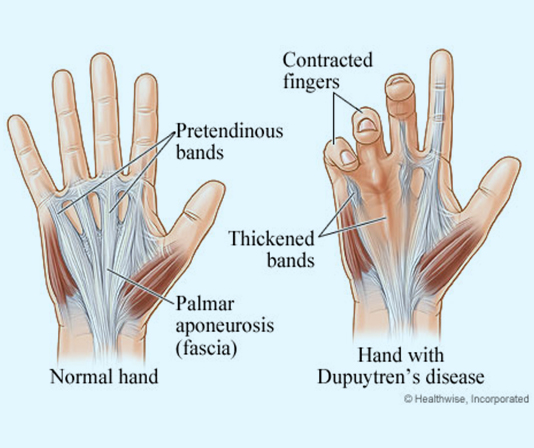Dupuytren’s Contracture
What is it?
Dupuytren’s contracture is a painless condition caused by the development of thick fibrotic scars in the palm of the hand. Over time, progression of these fibrous strands prevents the fingers from having the ability to straighten or open completely.

Dupuytren’s Contracture
What are the symptoms?
One or more fingers can be involved which bend toward the palm of the hand, most often being the pinky and ring fingers. This is a result of a firm lump at the palm of the hand which eventually tightens and pulls the finger(s) towards the palm. In more severe forms of Dupuytren’s disease, the feet and penises of patients can also be affected.
What is the cause?
There is no direct cause to this condition, however, it is thought to be genetically inherited as presents more commonly in individuals of northern European heritages and is more common in men.
How is it treated?
Dupuytren’s disease can be treated either by a surgical debridement or through an injection of enzymes called hyuronidase (called Xiaflex) which breakdowns the thick fibrous strands in the fascia. Unfortunately, Xiaflex is currently not available in Canada and can only be purchased privately in the USA.
Before surgery preparations
You will be asked to see an occupational hand therapist prior to your surgery. During that time, the therapist will make a custom fitted splint for your finger to be worn after your surgery. The splint will hold your finger(s) in a straight position and prevent it from scarring and contracting back to its original position.
During surgery
- First, your incision site is numbed using local anesthesia. After your hand is numbed, you will not feel any pain. However, during surgery you may feel some pushing and pulling while your surgeons are working on your hand, just like you do at the dentist.
- Right before the surgery begins, a tight cuff will be placed on your upper arm to constrict blood flow. The cuff will be inflated for approximately 5 to 10 minutes and may cause some discomfort.
- An incision will be made in the palm to allow the surgeon to debride the thick fibrous strands.
- Once complete, the incision will be sutured, wrapped with dressings, and you will wear the custom fitted splint made by the occupational therapist.
After surgery management
What to expect
- If you experience pain, you may take over-the-counter Tylenol Extra Strength (Acetaminophen) or Advil (Ibuprofen) for pain relief. If you need stronger medication, your surgeon can prescribe that to you. If you are experiencing severe pain, please contact your physician or go to the emergency room.
- Please note that swelling in the fingers is normal after your surgery. If the Tensors are too constrictive, you may remove them and please leave gauze in place for 2 days.
How to manage your wound
- For at least 2 days after the surgery, keep the dressing clean, dry, and intact.
- After 48 hours, you may remove the dressing and tensors (elastic bandage).
- After the removal of your bandages, wash the wound(s) with soap and water at least 3 times a day, and expose it to air to allow it to dry. Apply a thin layer of Polysporin to the incision site.
- You will continue to wear your splint for 4-6 weeks after surgery. Every hour, you should remove your splint and open and close your hand to prevent stiffness in your hand. You will also need to exercise your hand several times a day.
- Your follow-up appointment should be 10 to 14 days after the procedure for your doctor to assess the wound and remove the sutures.
- Please note that a bit of swelling over the incision is normal. However, watch out for signs of infection such as redness that spreads beyond your incision(s), skin breaking open, and/or pus draining from the incision(s).
- If you experience any of these signs of infection, please call your surgeon to book an appointment as soon as possible or go to the emergency room.
Please click on the link below to watch a video from Dr. Hong’s YouTube channel on post-op care instructions:
Exercises for recovery
- You may start using your hands within 2 days after surgery while wearing the splint.
- However, avoid heavy lifting or strenuous activity until the sutures are removed at your follow-up appointment.
- Feeling hardness over the incision site after surgery is normal as it is a result of scar tissue development. After your stitches are removed, you should massage the area 3-4 times a day to help heal the skin and help with the sensitivity that develops with non-use. Over time, the hardness should go away.
- Depending on the duration and severity of your condition, you may need some occupational therapy sessions to help restore the range of motion.

